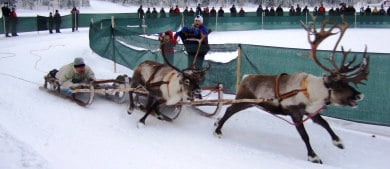We shiver uncontrollably after stepping off the bus into the bitter cold gripping the northern Swedish town of Jokkmokk. But here a few kilometres above the Arctic Circle, it soon becomes clear the frosty -11 degrees Celsius is considered downright balmy by some travelling to the region’s traditional annual market.
“This is a nice temperature”, says a man from Lapland’s indigenous Sami people who had driven over the border from Norway to Jokkmokk. “It was minus 35 when I was last here”.
The snow is thick on the ground and causes tree branches to droop precariously, but the streets of the town are still bustling. Market stalls are gearing up for three days of intense trading, as tens of thousands of people prepare to descend on Jokkmokk for what has been dubbed the world’s coldest market.
Created by Sweden’s King Karl IX as a means of exerting control over the country’s vast northern territories and increasing taxes, Jokkmokks marknad boasts a 400-year-old history. It takes place from the first Thursday to Sunday each February and draws visitors from across the region and further a field. They come not only for the market, but also for attractions including reindeer racing, traditional Sami yoik singing and liberally flowing alcohol.
The tightly packed stalls are filled with a preponderance of hides, pelts, and furs that would incense any animal rights advocate. Hats made out of whole foxes sit atop many traders’ heads and an elk carcass is drooped across the top of a smashed car to highlight the dangers of an impact with the region’s largest mammal. Elsewhere, I peruse stalls with beautiful – and expensive – Sami arts and handicrafts. I’m quickly forced to tighten my purse strings to avoid blowing thousands of kronor on their craftsmanship.
I opt instead to spend my money on warming sustenance against the bitter cold. Reindeer dominates the menus of the town’s eateries, so I choose the staple fare of reindeer mince with mashed potatoes, causing my vegetarian sister to cringe. But it could have been worse – for those with a more adventurous palate, the museum restaurant offers a three-course dinner with bear meat.
Well fortified against the cold, we plunge back out into the market just as a herd of reindeer makes its midday rounds amid a sea of eagerly patting hands. But before long we once again need to get out of the Arctic cold, so we duck into a Sami tent for coffee. Sitting atop reindeer hides insulated by spruce boughs, we warm our hands over the birch fire.
The tiny hamlet of Jokkmokk is the cultural capital of the Sweden’s indigenous Sami people. The local cultural centre offers courses in their Finno-Ugric language, handicrafts and reindeer herding. All around the town, visitors encounter the vivid blues, reds and yellows of traditional Sami dress during the annual market. However, up until only recently a legacy of Swedish discrimination made many of the locals feel ashamed to be Sami.
But nowadays there is a clear resurgence in Sami pride in their heritage and identity. During our visit, while trying to get into a dance later in the evening, I’m certainly in the plain-clothes minority in a queue of Sami youths. Chatting on mobile phones, they could be young people outside a club anywhere in the world – were it not for their traditional outfits replete with curled reindeer boots.
The next day, the reindeer race held on a frozen lake more than lives up to our expectations. The presenter gets us warmed up by encouraging the crowd to do the wave while the reindeer are saddled up. Then they hurtle off at great speed around a set course. One woman is thrown – somewhat alarmingly – from the sleigh as her animal careers off into the nylon netting.
That evening, a young and promising Sami singer gives a premier of his debut album in the Folkets Hus. One of the oldest forms of singing in Europe, yoiking’s resonant tones evoke the joys and tribulations of the Sami’s once nomadic lifestyle. Even after leaving the hall ninety minutes later still we’re still entranced.
On the final day Sunday, the whirlwind of the market comes to an end and the traders pack up their remaining wares. The streets seem almost forlorn and empty, with only a few older people sliding along in their sleds to do their daily errands. “Every year we enjoy the market”, says a local artist. “But we also enjoy the peace when it’s over”. After three days of frenetic activity, we agree that it’s time for some rest.
Getting There
The market takes place on the first Thursday to Sunday of each February. There is also a historical market that takes place over three days preceding the main market. Accommodation gets booked up quickly, so it is best to book well in advance. It is possible to reach Jokkmokk by train from Stockholm to Murjek, and then by taking a connecting bus. Alternatively, it is possible to fly, with the nearest airports in Luleå and Gällivare.


 Please whitelist us to continue reading.
Please whitelist us to continue reading.